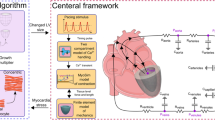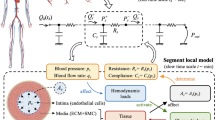Abstract
Our laboratory is studying the influence of the volume fractions and the organization of various macromolecules and cells in vascular tissue on the physical properties of vessel wall. The current investigation reports various mechanical properties of aorta, vena cava, carotid artery and iliac artery of the swine including: low-strain and high-strain moduli, transition from low-strain to high-strain behavior, the ultimate tensile stress, and the ultimate strain. Tissues were tested using a uniaxial incremental stress–strain technique, which allowed us to capture viscous, elastic, and total data simultaneously. Vessels were strained throughout their entire strain range until failure was achieved. Low-strain modulus showed sporadic differences between blood vessels and some dependence on strain-rate. The high-strain modulus was consistently greater in vena cava (2.2 MPa for viscous stress–strain—9.6 MPa for total stress–strain) than other vessels. The ultimate tensile strength of vena cava (0.46 MPa for viscous and 2.5 MPa for total) was again greater than in other vessels and there was some strain-rate dependence. The ultimate strain of carotid artery (180%) was greater in the transverse direction than in other vessels. Viscosity measurements indicated that blood vessels are thixotropic (viscosity decreased 2 orders of magnitude for 2 orders of magnitude increase in strain-rate). Our data suggests that differences in mechanical properties of blood vessels occur depending on where in the vascular tree the tissue is located. These differences may be required by the physiological and mechanical demands on individual vessels.
Similar content being viewed by others
References
Bailey AJ, Paul RG, and Knott L. Mechanisms of maturation and ageing of collagen. Mech Ageing Dev 106: 1–56, 1998.
Basta G, Schmidt AM, and De Caterina R. Advanced glycation end products and vascular inflammation: Implications for accelerated atherosclerosis in diabetes. Cardiovasc Res 63: 582–592, 2004.
Benetos A, Waeber B, Izzo J, Mitchell G, Resnick L, Asmar R, and Safar M. Influence of age, risk factors, and cardiovascular and renal disease on arterial stiffness: Clinical applications. Am J Hypertens 15: 1101–1108, 2002.
Bjarnegard N, Ryden Ahlgren A, Sonesson B, and Länne T. The effect of sympathetic stimulation on proximal brachial artery mechanics in humans—differential behavior within the length of the brachial artery. Acta Physiol Scand 182: 21–27, 2004.
Bortolotto LA, Blacher J, Kondo T, Takazawa K, and Safar ME. Assessment of vascular aging and atherosclerosis in hypertensive subjects: Second derivative of photoplethysmogram versus pulse wave velocity. Am J Hypertens 13: 165–171, 2000.
Boughner DR, Haldenby M, Hui AJ, Dunmore-Buyze J, Talman EA, and Wan WK. The pericardial bioprosthesis: Altered tissue shear properties following glutaraldehyde fixation. J Heart Valve Dis 9: 752–760, 2000.
Bruel A, Ortoft G, and Oxlund H. Inhibition of cross-links in collagen is associated with reduced stiffness of the aorta in young rats. Atherosclerosis 140: 135–145, 1998.
Carew EO, Barber JE, and Vesely I. Role of preconditioning and recovery time in repeated testing of aortic valve tissues: Validation through quasilinear viscoelastic theory. Ann Biomed Eng 28: 1093–1100, 2000.
Chapleau MW, Li Z, Meyrelles SS, Ma X, and Abboud FM. Mechanisms determining sensitivity of baroreceptor afferents in health and disease. Ann N Y Acad Sci 940: 1–19, 2001.
Cox RH. Basis for the altered arterial wall mechanics in the spontaneously hypertensive rat. Hypertension 3: 485–495, 1981.
Dijk JM, van der Graaf Y, Grobbee DE, Banga JD, and Bots ML. Increased arterial stiffness is independently related to cerebrovascular disease and aneurysms of the abdominal aorta: The Second Manifestations of Arterial Disease (SMART) Study. Stroke 35: 1642–1646, 2004.
Elsner R, Hanafee WN, and Hammond DD. Angiography of the inferior vena cava of the harbor seal during simulated diving. Am J Physiol 220: 1155–1157, 1971.
Fahim M. Cardiovascular sensory receptors and their regulatory mechanisms. Ind J Physiol Pharmacol 47: 124–146, 2003.
Faury G. Function-structure relationship of elastic arteries in evolution: from microfibrils to elastin and elastic fibres. Pathol Biol (Paris) 49: 310–325, 2001.
Fischer GM, Swain ML, and Cherian K. Increased vascular collagen and elastin synthesis in experimental atherosclerosis in the rabbit. Variation in synthesis among major vessels. Atherosclerosis 35: 11–20, 1980.
Gefen A, and Margulies SS. Are in vivo and in situ brain tissues mechanically similar? J Biomech 37: 1339–1352, 2004.
Griffin M, Casadio R, and Bergamini CM. Transglutaminases: Nature's biological glues. Biochem J 368: 377–396, 2002.
Gutsmann T, Fantner GE, Venturoni M, Ekani-Nkodo A, Thompson JB, Kindt JH, Morse DE, Fygenson DK, and Hansma PK. Evidence that Collagen Fibrils in Tendons Are Inhomogeneously Structured in a Tubelike Manner. Biophys J 84: 2593–2598, 2003.
Halloran BG, Davis VA, McManus BM, Lynch TG, and Baxter BT. Localization of aortic disease is associated with intrinsic differences in aortic structure. J Surg Res 59: 17–22, 1995.
Holzapfel GA, Gasser TC, and Ogden RW. Comparison of multi-layer structural model for arterial walls with a Fung-type model, and issues of material stability. J Biomech Eng 126: 264–275, 2004.
Horvath I, Foran DJ, and Silver FH. Energy analysis of flow induced harmonic motion in blood vessel walls. Cardiovasc Eng 5: 21–28, 2005.
Kalath S, Tsipouras P, and Silver FH. Increased aortic root stiffness associated with osteogenesis imperfecta. Ann Biomed Eng 15: 91–99, 1987.
Kelly RP, Tunin R, and Kass DA. Effect of reduced aortic compliance on cardiac efficiency and contractile function of in situ canine left ventricle. Circ Res 71: 490–502, 1992.
Langelier E, and Buschmann MD. Increasing strain and strain rate strengthen transient stiffness but weaken the response to subsequent compression for articular cartilage in unconfined compression. J Biomech 36: 853–859, 2003.
Li LP, and Herzog W. Strain-rate dependence of cartilage stiffness in unconfined compression: The role of fibril reinforcement versus tissue volume change in fluid pressurization. J Biomech 37: 375–382, 2004.
Lynch HA, Johannessen W, Wu JP, Jawa A, and Elliott DM. Effect of fiber orientation and strain rate on the nonlinear uniaxial tensile material properties of tendon. J Biomech Eng 125: 726–731, 2003.
Medynsky AO, Holdsworth DW, Sherbrin MH, Rankin RN, and Roach MR. The effect of storage time and repeated measurement on the elastic properties of isolated porcine aortas using high resolution X-ray CT. Can J Physiol Pharmacol 76: 451–456, 1998.
Mizutani K, Ikeda K, Kawai Y, and Yamori Y. Biomechanical properties and chemical composition of the aorta in genetic hypertensive rats. J Hypertens 17: 481–487, 1999.
Monson KL, Goldsmith W, Barbaro NM, and Manley GT. Axial mechanical properties of fresh human cerebral blood vessels. J Biomech Eng 125: 288–294, 2003.
Monson KL, Goldsmith W, Barbaro NM, and Manley GT. Significance of source and size in the mechanical response of human cerebral blood vessels. J Biomech 38: 737–44, 2005.
Motokawa T, and Tsuchi A. Dynamic mechanical properties of body-wall dermis in various mechanical states and their implications for the behavior of sea cucumbers. Biol Bull 205: 261–275, 2003.
Myers BS, Woolley CT, Slotter TL, Garrett WE, and Best TM. The influence of strain rate on the passive and stimulated engineering stress–large strain behavior of the rabbit tibialis anterior muscle. J Biomech Eng 120: 126–132, 1998.
O'Rourke MF, and Safar ME. Relationship between aortic stiffening and microvascular disease in brain and kidney: cause and logic of therapy. Hypertension 46: 200–204, 2005.
Ozturk N. Passive mechanical properties of the guinea pig aorta and portal vein: A comparison in the low-frequency range. Gen Physiol Biophys 16: 139–149, 1997.
Pandit A, Lu X, Wang C, and Kassab GS. Biaxial elastic material properties of porcine coronary media and adventitia. Am J Physiol Heart Circ Physiol 288: H2581–H2587, 2005.
Patel DJ, Coleman BR, Carpentier RG, Mehrotra PP, Tearney RJ, Cothran LN, and Curry CL. Clinical relevance of distal arterial compliance. J Hypertens Suppl 10: S15–S17, 1992.
Pries AR, and Secomb TW. Control of blood vessel structure: Insights from theoretical models. Am J Physiol Heart Circ Physiol 288: H1010–H1015, 2005.
Robinson PS, Lin TW, Reynolds PR, Derwin KA, Iozzo RV, and Soslowsky LJ. Strain-rate sensitive mechanical properties of tendon fascicles from mice with genetically engineered alterations in collagen and decorin. J Biomech Eng 126: 252–257, 2004.
Roeder BA, Kokini K, Sturgis JE, Robinson JP, and Voytik-Harbin SL. Tensile mechanical properties of three-dimensional type I collagen extracellular matrices with varied microstructure. J Biomech Eng 124: 214–222, 2002.
Sauren AA, van Hout MC, van Steenhoven AA, Veldpaus FE, Janssen JD. The mechanical properties of porcine aortic valve tissues. J Biomech 16: 327–337, 1983.
Scott JE. Elasticity in extracellular matrix ‘shape modules’ of tendon, cartilage, etc. A sliding proteoglycan-filament model. J Physiol 553: 335–343, 2003.
Seliktar D, Nerem RM, and Galias ZS. Mechanical strain-stimulated remodeling of tissue-engineered blood vessel constructs. Tissue Eng 9: 657–666, 2003.
Shadwick RE. Mechanical design in arteries. J Exp Biol 202: 3305–3313, 1999.
Silver FH, Bradica G, and Tria A. Relationship among biomechanical, biochemical, and cellular changes associated with osteoarthritis. Crit Rev Biomed Eng 29: 373–91, 2001a.
Silver FH, Christiansen DL, Snowhill PB, and Chen Y. Transition from viscous to elastic-based dependency of mechanical properties of self-assembled type I collagen fibers. J Appl Polymer Sci 79: 134–142, 2000.
Silver FH, Ebrahimi A, and Snowhill PB. Viscoelastic properties of self-assembled type I collagen fibers: Molecular basis of elastic and viscous behaviors. Connect Tissue Res 43: 569–580, 2002a.
Silver FH, Horvath I, and Foran DJ. Mechanical implications of the domain structure of fiber-forming collagens: Comparison of the molecular and fibrillar flexibilities of the alpha1-chains found in types I-III collagen. J Theor Biol 216: 243–254, 2002b.
Silver FH, Horvath I, and Foran DJ. Viscoelasticity of the vessel wall: The role of collagen and elastic fibers. Crit Rev Biomed Eng 29: 279–301, 2001b.
Silver FH, Snowhill PB and Foran DJ. Mechanical behavior of vessel wall: A comparative study of aorta, vena cava, and carotid Artery. Ann Biomed Eng 31: 793–803, 2003.
Snowhill PB, Foran DJ, and Silver FH. A mechanical model of porcine vascular tissues-part I: Determination of macromolecular component arrangement and volume fractions. Cardiovasc Eng 4: 281–294, 2004.
Vande Geest JP, Sacks MS, and Vorp DA. Age dependency of the biaxial biomechanical behavior of human abdominal aorta. J Biomech Eng 126: 815–822, 2004.
Verteramo A, and Seedhom BB. Zonal and directional variations in tensile properties of bovine articular cartilage with special reference to strain rate variation. Biorheology 41: 203–213, 2004.
Wang JJ, and Parker KH. Wave propagation in a model of the arterial circulation. J Biomech 37: 457–470, 2004.
Wang YX, and Fitch RM. Vascular stiffness: Measurements, mechanisms and implications. Curr Vasc Pharmacol 2: 379–384, 2004.
Weiss JA, Gardiner JC, and Bonifasi-Lista C. Ligament material behavior is nonlinear, viscoelastic, and rate-independent under shear loading. J Biomech 35: 943–950, 2002.
Yahia LH, and Drouin G. Study of the hysteresis phenomenon in canine anterior cruciate ligaments. J Biomed Eng 12: 57–62, 1990.
Yang S, Litchfield JE, and Baynes JW. AGE-breakers cleave model compounds, but do not break Maillard crosslinks in skin and tail collagen from diabetic rats. Arch Biochem Biophys 412: 42–46, 2003.
Zieman S, and Kass D. Advanced glycation end product cross-linking: pathophysiologic role and therapeutic target in cardiovascular disease. Congest Heart Fail 10: 144–149, 2004.
Zulliger MA, Fridez P, Hayashi K, and Steriopulos N. A strain energy function for arteries accounting for wall composition and structure. J Biomech 37: 989–1000, 2004.
Author information
Authors and Affiliations
Corresponding author
Rights and permissions
About this article
Cite this article
Snowhill, P.B., Silver, F.H. A Mechanical Model of Porcine Vascular Tissues-Part II: Stress–Strain and Mechanical Properties of Juvenile Porcine Blood Vessels. Cardiovasc Eng 5, 157–169 (2005). https://doi.org/10.1007/s10558-005-9070-1
Issue Date:
DOI: https://doi.org/10.1007/s10558-005-9070-1




